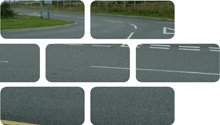
Asphalt Inert 17 03 02
Asphalt is a bituminous mixture of bitumen, stone and in some applications polymer modified binders to produce hot mix asphalts, macadams and mastic asphalt. It is a highly durable and waterproof material that is relatively inert at normal temperature. Excavated asphalt may also contain sand or crushed stone from sub base layers which are also inert. Asphalt will be of varying colour, quality and mixture depending on their previous function. Asphalt containing coal tar is a hazardous material - see separate DRIDS.
Usage & Probable Locations
Asphalt is commonly used as a surface dressing, roofing material, road surfacing layer and some sub base layers of highways, pavements, car parks, airfields, stadiums and household driveways. It is also used as mastic asphalt for flooring materials. Crushed asphalt is also used in-situ to form piling mats during demolition, sub-base layers in new road construction, filling voids and as a partial feedstock for the production of new asphalt for highways, pavements, car parks and driveways.
Personal Protective Equipment
PPE requirements indicated are for guidance purposes only. DRIDS has identified the PPE that is mandatory on all demolition projects and ones that may be required subject to site specific Risk Assessment & Method Statement (RAMS). Hover over the icon to determine the types of PPE required for the removal of this material.
Removal, Segregation & Storage
Asphalt products can be excavated removed using suitable plant and equipment and stored in piles of crushed materials that have been screened to remove contaminants such as wood, metal and fines. This crushed material destined for reuse or recycling should meet the quality protocol for recycled aggregates and asphalt specifications, then stockpiled in mounds according to their intended use. They should be stored away from current and intended activity to prevent multiple handling. There is no need to store crushed asphalt inside a building or under cover as they are robust against weather.
Tools
Fixtures, Fittings & Connections
Asphalt is a bituminous layer and paving product which does not need or have fixtures and fittings. They are laid into place, leveled, rolled and compacted to form layers or shapes without the use of mortars or mechanical fixings. Road and street furniture may be embedded into the products and should be removed before excavation. Minor contaminants, fines and dust will be part of the excavated materials.
Health & Safety
Subject to task-specific Risk Assessment & Method Statement (RAMS). Wear gloves and respiratory protective equipment (where necessary) when working with excavated or crushed asphalt to prevent irritation, cuts and abrasion. Use eye protection when using hand tools. Limit hand, arm and whole body vibration when using air tools. Only use harness protection at height as a last resort. Only use 360 plant and attachments, loaders, muck shifters, mobile crushers or screeners if appropriately trained.
Further reading
- Quality Protocol for Recycled Aggregates
- Demolition Code of Practice
- WRAP Specification for Highways Works
- Refined Bitumen Association Guidance on Reuse & Recycling
- Day Group Recycled Aggregates
- BRE Digest 433 Recycled Aggregates
- EA Permit for Use of Mobile Plant
- Refined Bitumen Association PPE Toolbox Talk
- Asphalt Recycling UK
- Tarmac FoamMaster Recycled Asphalt










